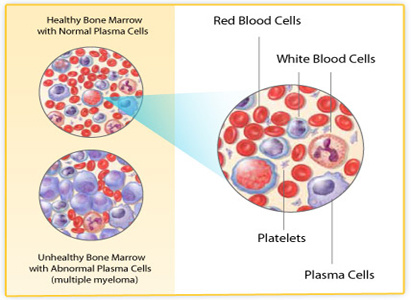Multiple myeloma is a type of cancer that is caused by plasma cells and often invades into multiple sites and tissues. In most cases, without biopsy ,a definite diagnosis also is obtained, while multiple myeloma’s diagnosis mainly depends on serum protein electrophoresis and laboratory biochemical tests. In some cases, when there is only single lesion, bone marrow aspiration to the no-diseased bone can identify whether multiple myeloma has been spread.

As early multiple myeloma patients don’t have symptoms of bone ache, anemia and changes of blood routine and urine routine, the physician should use following listed tests to decide whether one is diagnosed with multiple myeloma:
Serum test
Increase in serum abnormal globulin while normal or decrease in albumin, half urine Bence Jones protein shows positive.
Anemia: The result of anemia test usually shows normocytic and normochromic with normal or low platelet.
Bone marrow test: Changes in plasmacytic series dysplasia nature
Bone x-rays
Bone x-rays can detect bone defects , bone rarefaction or pathologic fracture.
Urine test
Routine urine examination shows proteinuria, microscopic hematuria, but rare cylindruria, and plasma cells at sometimes.
Renal function test
Renal function impaired , especially in the middle and late stage of multiple myeloma. Serum creatinine, urea nitrogen, creatinine clearance test, phenol red excretion test and radionucleiorenogram examination, which can determine whether renal function is impaired and the extent of damage.
Additionally, the diagnosis of multiple myeloma should distinguish with following diseases:
Plasmacytosis
Primary macroglobulinaemia and heavy chain disease
Benign monoclonal immunoglobulinemia
Senile osteoporosis
Bone metastasis
Experts of Modern Cancer Hospital Guangzhou advise that if you are diagnosed with multiple myeloma, you’d better go to a specialized cancer hospital to receive examination and treatment. specialized cancer hospital to receive examination and treatment.
 viber
viber